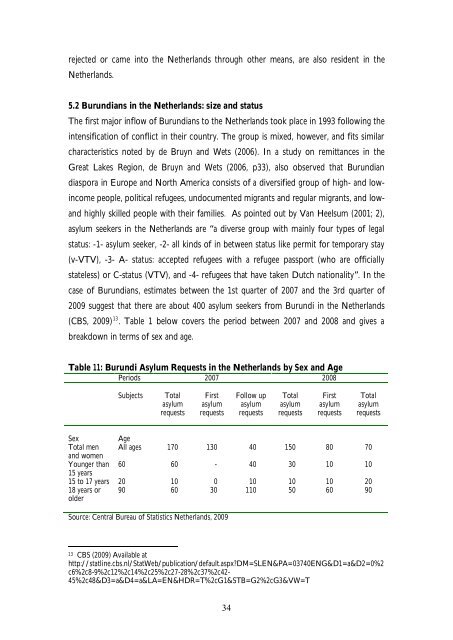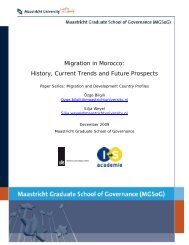Migration in Burundi: History, Current Trends and Future - MGSoG ...
Migration in Burundi: History, Current Trends and Future - MGSoG ...
Migration in Burundi: History, Current Trends and Future - MGSoG ...
You also want an ePaper? Increase the reach of your titles
YUMPU automatically turns print PDFs into web optimized ePapers that Google loves.
ejected or came <strong>in</strong>to the Netherl<strong>and</strong>s through other means, are also resident <strong>in</strong> the<br />
Netherl<strong>and</strong>s.<br />
5.2 <strong>Burundi</strong>ans <strong>in</strong> the Netherl<strong>and</strong>s: size <strong>and</strong> status<br />
The first major <strong>in</strong>flow of <strong>Burundi</strong>ans to the Netherl<strong>and</strong>s took place <strong>in</strong> 1993 follow<strong>in</strong>g the<br />
<strong>in</strong>tensification of conflict <strong>in</strong> their country. The group is mixed, however, <strong>and</strong> fits similar<br />
characteristics noted by de Bruyn <strong>and</strong> Wets (2006). In a study on remittances <strong>in</strong> the<br />
Great Lakes Region, de Bruyn <strong>and</strong> Wets (2006, p33), also observed that <strong>Burundi</strong>an<br />
diaspora <strong>in</strong> Europe <strong>and</strong> North America consists of a diversified group of high- <strong>and</strong> low-<br />
<strong>in</strong>come people, political refugees, undocumented migrants <strong>and</strong> regular migrants, <strong>and</strong> low-<br />
<strong>and</strong> highly skilled people with their families. As po<strong>in</strong>ted out by Van Heelsum (2001; 2),<br />
asylum seekers <strong>in</strong> the Netherl<strong>and</strong>s are “a diverse group with ma<strong>in</strong>ly four types of legal<br />
status: -1- asylum seeker, -2- all k<strong>in</strong>ds of <strong>in</strong> between status like permit for temporary stay<br />
(v-VTV), -3- A- status: accepted refugees with a refugee passport (who are officially<br />
stateless) or C-status (VTV), <strong>and</strong> -4- refugees that have taken Dutch nationality”. In the<br />
case of <strong>Burundi</strong>ans, estimates between the 1st quarter of 2007 <strong>and</strong> the 3rd quarter of<br />
2009 suggest that there are about 400 asylum seekers from <strong>Burundi</strong> <strong>in</strong> the Netherl<strong>and</strong>s<br />
(CBS, 2009) 13 . Table 1 below covers the period between 2007 <strong>and</strong> 2008 <strong>and</strong> gives a<br />
breakdown <strong>in</strong> terms of sex <strong>and</strong> age.<br />
Table 11: <strong>Burundi</strong> Asylum Requests <strong>in</strong> the Netherl<strong>and</strong>s by Sex <strong>and</strong> Age<br />
Periods 2007 2008<br />
Subjects Total<br />
asylum<br />
requests<br />
First<br />
asylum<br />
requests<br />
34<br />
Follow up<br />
asylum<br />
requests<br />
Total<br />
asylum<br />
requests<br />
First<br />
asylum<br />
requests<br />
Total<br />
asylum<br />
requests<br />
Sex Age<br />
Total men<br />
<strong>and</strong> women<br />
All ages 170 130 40 150 80 70<br />
Younger than<br />
15 years<br />
60 60 - 40 30 10 10<br />
15 to 17 years 20 10 0 10 10 10 20<br />
18 years or<br />
older<br />
90 60 30 110 50 60 90<br />
Source: Central Bureau of Statistics Netherl<strong>and</strong>s, 2009<br />
13 CBS (2009) Available at<br />
http://statl<strong>in</strong>e.cbs.nl/StatWeb/publication/default.aspx?DM=SLEN&PA=03740ENG&D1=a&D2=0%2<br />
c6%2c8-9%2c12%2c14%2c25%2c27-28%2c37%2c42-<br />
45%2c48&D3=a&D4=a&LA=EN&HDR=T%2cG1&STB=G2%2cG3&VW=T



